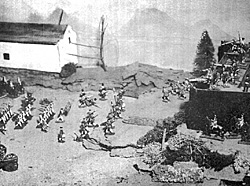 When a celebrated English pacifist and science fiction novelist, H.G. Wells, was discovered shooting a "Wm. Britains" 4-7 Spring loaded Naval gun, at toy soldiers, it was big news...bigger, perhaps, because Mr. Wells not only verified his participation on wargames as a hobby, he compiled and published the book, Little Wars, a book on wargames from the same mind that was responsible for The War of the Worlds and The Island of Dr. Moreau.
When a celebrated English pacifist and science fiction novelist, H.G. Wells, was discovered shooting a "Wm. Britains" 4-7 Spring loaded Naval gun, at toy soldiers, it was big news...bigger, perhaps, because Mr. Wells not only verified his participation on wargames as a hobby, he compiled and published the book, Little Wars, a book on wargames from the same mind that was responsible for The War of the Worlds and The Island of Dr. Moreau.
At right, Storming Fort Eagles Nest: From the Haskell Archives
The book Little Wars is popularly and rightly regarded as a milestone or landmark in the history of wargames as played with model soldiers. Mr. Wells is not the first adult to become involved in the hobby or sport of wargaming. The list of wargamers is filled with people from every walk of life, Robert Lewis Stevenson was a member of the ranks, who along with numerous others both great and small practiced the hobby behind closed doors, sharing the same fear of discovery that would surely bring public ridicule and scorn: "Toy soldiers were for little boys, not for grown men!!"
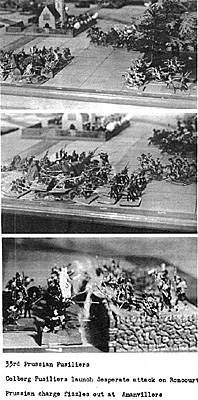
It was Wells, however, who had the audacity, combined with a biting wit, to assert man's right to the hobby. His book was not so much a prototype of modern wargame rules, but a "Magna Carta" of the player. Although progress to date has been rather sporadic, his book did open the closed door of a great pastime, by placing the miniature wargames in the category of numerous lively battle games that man has devised through the ages, games such as chess and checkers, to name but two.
There is a strange fascination for the armies of model soldiers, when seen in a battle array, and I am sure it is derived from the picturesque and often very colorful miniature soldiers as they are massed for battle. The use of miniature soldiers and vehicles as playing pieces affords numerous advantages over the popular board games, in that tactical units may be more easily reduced in capacity rather than 'repulsed' without serious loss or elimination. Disadvantages such as cost and space are being constantly reduced by the "player-collector" exercising discretion in purchasing, and the arrival of new scales,types of figures, and equipment that are increasing the ever-expanding market.
In numerous games, and with varying degrees of luck, skill, and panorama, wargamers put their collections to work, and the most popular era among the "buffs" (serious wargamers) is the "Napoleonic era", with the very vivid uniforms of blue, red, green, and white, turned facings, steel-clad cavalry, bright colored plumes, charging horses in exotic trappings, and gleaming bronze cannon, all add much to the excitement and thrills of a battle array.
The year 1965 was the one hundred and fifieth anniversary of Napoleon's final and bitter defeat. This anniversary saw red and blue ranks of 20mm, 30mm, and 54mm might locked in battle rematches from California to the East Coast, Canada to Mexico, Great Britain to South Africa and Australia.
In these uncountable battles there were cases of the French forces basking in the glory of victory, and in other battles they were barely able to hold their own and it would appear that the scripts followed the true course of history in a much larger part of the battles.
While almost all of the wargamers the world over were fighting battles from the Napoleonic wars, the French were regarding the Napoleonic era, in a large part with a momentary show of disfavor, even battles of Austerlitz had lost much of their fascination. What were the wargaming buffs of France up to? They were feverishly engaged in battles of "Les braves gens Federal et Sudistes" or the Civil War (Yankees and Rebels to yo'all).
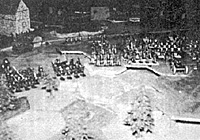 ACW game at St. Cloud courtesy of Pierre Foure, 20-23mm figures
ACW game at St. Cloud courtesy of Pierre Foure, 20-23mm figures
Three years of Civil War centennials just about overdid it for most of us in the States, but after 150 years of "Vive le Empereur" the French were looking for a change, and the end result saw "Blue & Gray" as the leading colors and fashions with the wargamers of Gay Paree .
The 'Modern Era' of wargaming is experiencing a rather rapid increase in popularity with wargamers of all ages. 'Modern' wargames can be virtually rule-less battles featuring any type of soldier, tank, plane or ship, the wargamer can get his hands on, to a well organized battle or "period" vehicles controlled by concise rules.
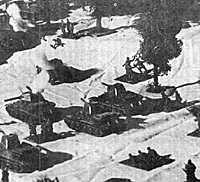 Eastern Front Scene 1942
Eastern Front Scene 1942
Though the modern method of war, with the use of camouflage, drab colors, and lusterless uniforms, is lacking in feeling when compared to the sparkle of Napoleon's gleaming cuirassiers or the crimson of Confederate banners, in our age of mechanization, the tanks, armored vehicles, and aircraft possess a certain fascination for the "Player collector."
Recently some enterprising devotees, have contrived a modern, even contemporary battle game, with an aura of of atomic fallout and bush fighting, which in the world situation of our present times, is being - bit too realistic for some tastes.
No discourse on miniature warfare, would be complete without mention of that played with medieval or ancient armies. The United States has no medieval history, and the ancient period is not given a very wide of in depth coverage by our school systems.
Although a bit less popular in the U.S. than in England and Europe, there is an active and growing group of wargamers that with the use of round or flat figures of metal, and the newer figures of plastic, are re-creating and fighting ancient and medieval battles on more and more American table tops every day. Being far removed in time and place from the events of recent history, these two periods not only contain a certain fascination for most wargamers, they also lend themselves easily to the improvisions of the "country inventor" as they are unmatched by more recent times with which a sense of literal history sometimes interferes.
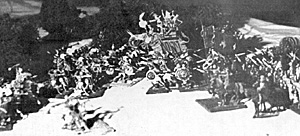 Elephants lead the charge
Elephants lead the charge
Always offering a lively and interesting hobby with wide scope for imagination, thought, and an artistic flair, the wargames of today, which use model soldiers, have come a long way over the past few years. Today's wargamers, with the benefit of wider contacts and considerable thought and study, plus larger selections of gamers, with the benefit of wider contacts and considerable thought and study, plus larger selections of soldiers and equipment to select from, have created new games, and improved upongolder games to such sophisticated levels, that they surely must exceed the wildest dreams of such remarkable gentlemen of the past, as H. G. Wells and Robert Louis Stevenson.
Back to The Armchair General Vol. 1 No. 1 Table of Contents
Back to The Armchair General List of Issues
Back to MagWeb Master Magazine List
© Copyright 1968 by Pat Condray
This article appears in MagWeb (Magazine Web) on the Internet World Wide Web. Other military history articles and gaming articles are available at http://www.magweb.com
